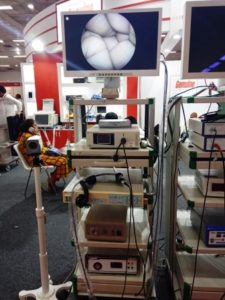ARTHROSCOPY surgery Console in Knee Joint surgery commonly performed minimally invasive procedure, where instruments are introduced into joints through a very small incision, enabling “key-hole” surgery. Used in the knee and elbow joint surgery in common
Knee the most common Joint where arthroscopy is done, followed by the shoulder, but the ankle, hip, wrist, and elbow joints were amenable to arthroscopy.
Arthroscopy in Knee Joint surgery performed in a sterile manner to reduce the infection
Useful for diagnostic. and also for the treatment of various conditions like meniscectomy. meniscal repair, anterior cruciate ligament reconstruction, foreign body/loose body removal. synovectomy, etc.
Procedure
Tourniquet used for most cases. The arthroscope consists of a rod-lens system (which magnifies the image), a solid-state camera (which improves resolution and color), and a fiber-optic light source. The camera transmits the picture to a television monitor. The joint continuously irrigated (with ringer lactate/normal saline) which ensures clear vision, and joint-distension with the fluid helpful for hemostasis.
One skin portal used tor the arthroscope, while another used for the introduction of other operating instruments like the probe. After the procedure, skin incisions closed by 1 or 2 stitches, and the patient may go home the same day (Day Care surgery).
Elbow joint surgery positioning the patient needs technical support from the technician and a good table with support accessories
Advantages
1. Low morbidity: Reduces post-operative pain, ensures quick rehabilitation.
2. Cosmetic: No ugly scars, due to very small skin incisions.
3. Cost-effective: Less hospital stay, fewer complications, and thus less cost.
4.More accuracy: Structures can be seen (even when the joint is moving) and “palpated” by the probe (most commonly used arthroscopic instrument) and biopsied.
Disadvantages
Steep learning curve: Since arthroscope provides mono-ocular and 2-dimensional vision, depth perception is difficult. Skill only comes with extensive practice and experience, which takes a long time.
Complications
- Haemarthrosis.
- Infection.
- Thromboembolic disease.
- Damage to intra-articular structures.
Contraindication
Risk of septic arthritis due to a local skin condition, or a remote infective focus
Ankylosis is a relative contraindication.

